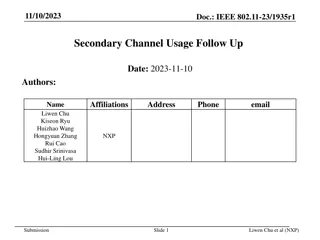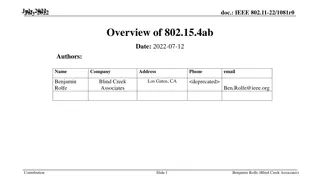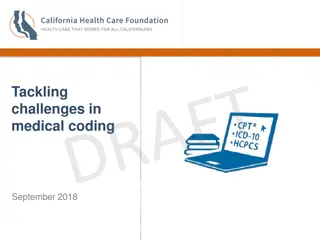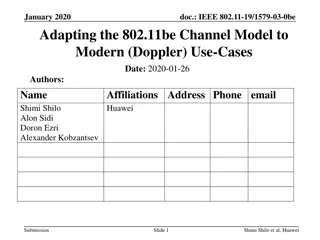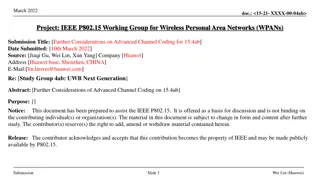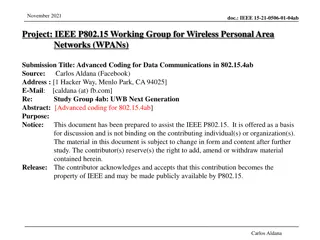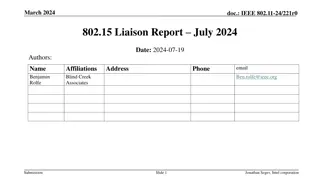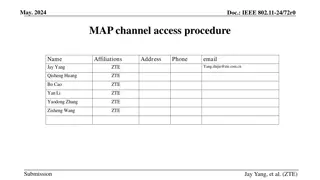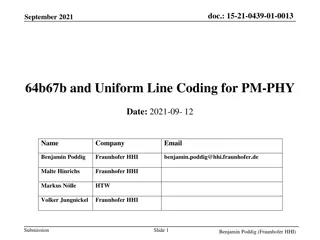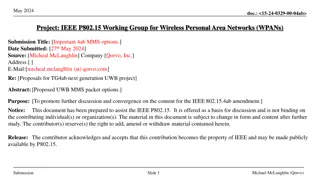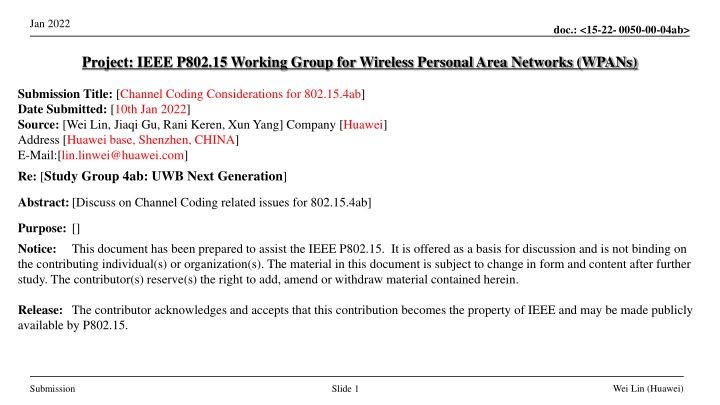
Channel Coding Considerations for IEEE 802.15.4ab Standard
The document submitted by Wei Lin from Huawei discusses advanced channel coding considerations for the IEEE 802.15.4ab standard, focusing on enhancing data communication throughput and reliability. It explores the need for new Forward Error Correction (FEC) codes like LDPC and Polar codes, emphasizing the importance of carefully selecting code lengths and rates. The proposed solutions aim at improving link budgets, reducing airtime, supporting high data rates, and ensuring compatibility with future technologies. Additional submissions on advanced coding for data communication and achieving high data rates are referenced, highlighting ongoing research in the field.
Download Presentation

Please find below an Image/Link to download the presentation.
The content on the website is provided AS IS for your information and personal use only. It may not be sold, licensed, or shared on other websites without obtaining consent from the author. If you encounter any issues during the download, it is possible that the publisher has removed the file from their server.
You are allowed to download the files provided on this website for personal or commercial use, subject to the condition that they are used lawfully. All files are the property of their respective owners.
The content on the website is provided AS IS for your information and personal use only. It may not be sold, licensed, or shared on other websites without obtaining consent from the author.
E N D
Presentation Transcript
Jan 2022 doc.: <15-22-0050-00-04ab> Project: IEEE P802.15 Working Group for Wireless Personal Area Networks (WPANs) Submission Title: [Channel Coding Considerations for 802.15.4ab] Date Submitted: [10th Jan 2022] Source: [Wei Lin, Jiaqi Gu, Rani Keren, Xun Yang] Company [Huawei] Address [Huawei base, Shenzhen, CHINA] E-Mail:[lin.linwei@huawei.com] Re: [Study Group 4ab: UWB Next Generation] Abstract: [Discuss on Channel Coding related issues for 802.15.4ab] Purpose: [] Notice: the contributing individual(s) or organization(s). The material in this document is subject to change in form and content after further study. The contributor(s) reserve(s) the right to add, amend or withdraw material contained herein. This document has been prepared to assist the IEEE P802.15. It is offered as a basis for discussion and is not binding on Release: The contributor acknowledges and accepts that this contribution becomes the property of IEEE and may be made publicly available by P802.15. Wei Lin (Huawei) Submission Slide 1
Jan 2022 doc.: <15-22-0050-00-04ab> Technical Guidance PAR Objective Proposed Solution (how addressed) Safeguards so that the high throughput data use cases will not cause significant disruption to low duty-cycle ranging use cases. Interference mitigation techniques to support higher density and higher traffic use cases Other coexistence improvement Backward compatibility with enhanced ranging capable devices (ERDEVs). Improved link budget and/or reduced air-time New channel Coding Schemes can provide improved link budgets and reduced air time Additional channels and operating frequencies Improvements to accuracy / precision / reliability and interoperability for high-integrity ranging; Reduce complexity and power consumption; Hybrid operation with narrowband signaling to assist UWB; Enhanced native discovery and connection setup mechanisms; Sensing capabilities to support presence detection and environment mapping; Low-power low-latency streaming higher data-rate streaming allowing at least 50 Mbit/s of throughput. New channel Coding Schemes with higher rates can support high data-rate Support for peer-to-peer, peer-to-multi-peer, and station-to-infrastructure protocols; Infrastructure synchronization mechanisms. Wei Lin (Huawei) Submission Slide 2
Jan 2022 doc.: <15-22-0050-00-04ab> Related Submissions [1] 15-21-0506-01-04ab-advanced-coding-for-data-comm, Aldana (Facebook) [2] 15-21-0592-00-04ab-high-data-rates, Murray, et al (Qorvo) Wei Lin (Huawei) Submission Slide 3
Jan 2022 doc.: <15-22-0050-00-04ab> Channel Coding Considerations - Overview As of today, IEEE 802.15.4z standard supports data communication of relative small amounts of data with throughput of 31.2 mbps. No Capacity-Approaching FEC codes (LDPC, Turbo, Polar, etc.) has been adopted yet IEEE 802.15.4a employed a rate-1/2 convolutional codes of K=3 (4 states) as well as an (63, 55) GF(26) Reed-Solomon Codes To further enhance the performance, 802.15.4z optionally introduced an standard rate-1/2 convolutional codes of K=7 (64 states) For the current 802.15.4ab standard, the needs for higher throughput as well as higher reliability have been discussed The introduction of advanced-coding has been discussed in [1], [2] To consider the inclusion of new FEC codes, especially block codes (LDPC, Polar), the candidate code-lengths and code-rates shall be carefully considered Wei Lin (Huawei) Submission Slide 4
Jan 2022 doc.: <15-22-0050-00-04ab> Channel Coding in 15.4a The channel coding process of payload consists of several steps The payload data is RS encoded with RS(63,55) (378, 330), R=0.87. The next step performs further systematic convolutional coding for the PHR and the payload data The inner rate R = BCC encoder: generator polynomials g0 = [010] and g1 = [101]. Each PPDU, the encoder shall be initialized to the all zero state, and shall be returned to the all zero state by appending two zero bits to the PPDU. During the standardization of 15.4a, varies FEC codes were discussed Convolutional codes with K = 3,4,5 were considered and compared K = 3 Final BCH codes and RS codes of varies lengths and rates were also discussed The final selection was a balance between performance and decoding complexities, e.g., the RS(63, 55) on GF(26) was compared with RS(40,32) on GF(28) Wei Lin (Huawei) Submission Slide 5
Jan 2022 doc.: <15-22-0050-00-04ab> Channel Coding in 15.4z The HRP-ERDEV in its HPRF mode may optionally employ the K = 7 convolutional encoder, with the generator polynomials (133,171). Before transmission of each PPDU, this encoder shall be initialized to all zero state, and shall be returned to all zero state by separately appending six zero bits to both the PHR and the PSDU. Non-systematic convolutional encoder Simulation performed for 21-byte PSDU 15-18-0335-00-004z-srdev-ppdu-for-enhanced-impulse-radio Wei Lin (Huawei) Submission Slide 6
Jan 2022 doc.: <15-22-0050-00-04ab> Channel Coding Considerations in 15.4ab The consideration of introducing new advanced coding schemes were discussed in [1] and [2] [1] proposed to include LDPC codes as an optional solution after an extensive comparison of Turbo, Polar, NR LDPC, and 11n LDPC codes [2] proposed to identify suitable candidate advanced codes for high-speed data, e.g., NR LDPC, 11n LDPC, candidates for Turbo and Polar codes and possibly additional LDPC codes [2] states that the power consumption at a given performance should be a central selection metric To compare and select a candidate code, several parameters shall be agreed for further investigations The candidate code rates: the standard code rate is R = for 15.4z HPRF mode, do we need higher code rates (e.g. 2/3, 3/4) to further increase the peak data throughput? The candidate code length selection is very important for further evaluations. Wei Lin (Huawei) Submission Slide 7
Jan 2022 doc.: <15-22-0050-00-04ab> Discussion on Code Length During the development of 15.4a, the employed RS(63, 55) of length n = 63x6 = 378 bits was extensively compared with BCH codes (e.g., BCH(292,256), BCH(328,256)) and other RS codes (e.g., RS(40,32) over GF(28), RS(51,43) over GF(26)) The selected codeword length shall best balance the performance, padding/puncturing, and complexity The codeword lengths of 11n LDPC were selected to minimize the padding bits for OFDM symbols Short Length: the number of shortening/padding bits can be minimized, while the error correction capability of the code is limited suitable for short payloads Long Length: the inherent error correction capability is strong, however, relative large amount of shortening or padding bits are incurred, which would deteriorate the code performance suitable for relative long payloads Since the maximum PSDU length has been increased from 127 bytes in 15.4a to 1023 bytes in 15.4z (optionally to 4095 bytes), shall we consider longer lengths (e.g., around n = 648 (11n) ~672(11ad))? Wei Lin (Huawei) Submission Slide 8
Jan 2022 doc.: <15-22-0050-00-04ab> LDPC Codes in WLAN Low-Density Parity-Check (LDPC) codes in 11n/ac and 11ad/ay Rate-1/2 & Shortest 11n LDPC: Rate-1/2, Base Matrix: 12x24, N = 648, Z = 27 11ad LDPC: Rate-1/2, Base Matrix: 8x16, N = 672, Z = 42 LDPC encoding with shortening & puncturing for small payloads Information Bits Shortened Zeros Parity Bits Punctured Bits Encoded Codeword Bits Information Bits Parity Bits Transmitted Bits Wei Lin (Huawei) Submission Slide 9
Jan 2022 doc.: <15-22-0050-00-04ab> Polar Codes: Preliminaries Channel polarization [1]: the key idea behind polar coding N independent copies of sub-channels can be transformed into multiple synthetic channels. The synthetic channels are polarized their capacity are either approaching 0 or 1 as code length tends to infinity Information bits are placed at the most K reliability positions, while frozen bits are set to 0 and placed at rest positions Successive Cancellation Decoding (SC) [1] Low complexity, simple decoding structure Successive Cancellation List Decoding (SCL) [2] Retaining L decoding paths during the decoding process and select the one with the highest probability CRC can be added to further enhance the performance (CA-SCL) Ref: https://simons.berkeley.edu/sites/default/files/docs/2689/slidesarikan.pdf [1] E. Ar kan, Channel polarization: A method for constructing capacity achieving codes for symmetric binary-input memoryless channels, IEEE Trans. Inform. Theory, vol. 55, no. 7, pp. 3051 3073, July 2009 [2] I. Tal and A. Vardy, "List Decoding of Polar Codes," in IEEE Transactions on Information Theory, vol. 61, no. 5, pp. 2213-2226, May 2015 Wei Lin (Huawei) Submission Slide 10
Jan 2022 doc.: <15-22-0050-00-04ab> Polar Codes in NR Polar encoding for NR control channel (Blue blocks are for uplink only, and red blocks are for downlink only) UCI/DCI CRC Polar encoding Rate Matching Segmentation Concatenation interleaver attachment Uplink: ????= 1024 Channel Interleaver Sub-block interleaving Rate matching circular buffer Downlink: ????= 512 Puncturing: if ? ? and ? 7 16, the first ? = ? ? bits are not transmitted Shortening: if ? ? and ? > 7 16, the last ? = ? ? bits are not transmitted Repetition: if ? > ?, the first ? = ? ? bits are transmitted twice Circular buffer design for rate-matching [1] [1] V. Bioglio, C. Condo and I. Land, "Design of Polar Codes in 5G New Radio," in IEEE Communications Surveys & Tutorials, vol. 23, no. 1, pp. 29-40, Firstquarter 2021, doi: 10.1109/COMST.2020.2967127. Wei Lin (Huawei) Submission Slide 11
Jan 2022 doc.: <15-22-0050-00-04ab> Simulation Assumptions BCC (K = 7) LDPC Code: 11n LDPC, 11ad LDPC, New LDPC? Polar Code: NR Polar and New Polar? Code Rate: R = as a start point Code Length: N around (320~672 bits) 648 bits: the current shortest code length of 11n/ac/ax LDPC 672 bits: the current shortest code length of 11ad/ay LDPC 512 bits: for Polar codes as an initial evaluation 320 bits: The final transmitted bits after rate matching for payload of 20 bytes (to align with packet length of BCC) PER/BLER: the performance were compared at 1% PER in 15.4a Mode: HPRF mode with Data Rate of 31.2Mbps Wei Lin (Huawei) Submission Slide 12
Jan 2022 doc.: <15-22-0050-00-04ab> Preliminary Simulations HPRF mode with Data Rate of 31.2Mbps Wei Lin (Huawei) Submission Slide 13
Jan 2022 doc.: <15-22-0050-00-04ab> Straw Poll 1 Which code rate are you in favor of in 15.4ab? Option 1: Only one base code rate: R = 1/2 Option 2: Include an additional higher code rate: e.g., R = 2/3, or R = 3/4 Abstain Wei Lin (Huawei) Submission Slide 14
Jan 2022 doc.: <15-22-0050-00-04ab> Straw Poll 2 Which code lengths shall we consider for 15.4ab? Option 1: around 378 bits (RS in BPRF mode) Option 2: around 512 bits (power of 2) Option 3: around 672 bits (Shortest 11n LDPC) Option 4: longer, e.g., > 672 bits Abstain Wei Lin (Huawei) Submission Slide 15
Jan 2022 doc.: <15-22-0050-00-04ab> Thank You Wei Lin (Huawei) Submission Slide 16




